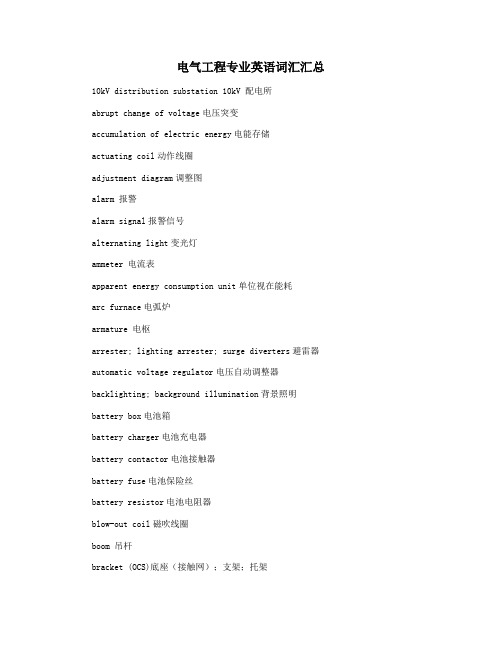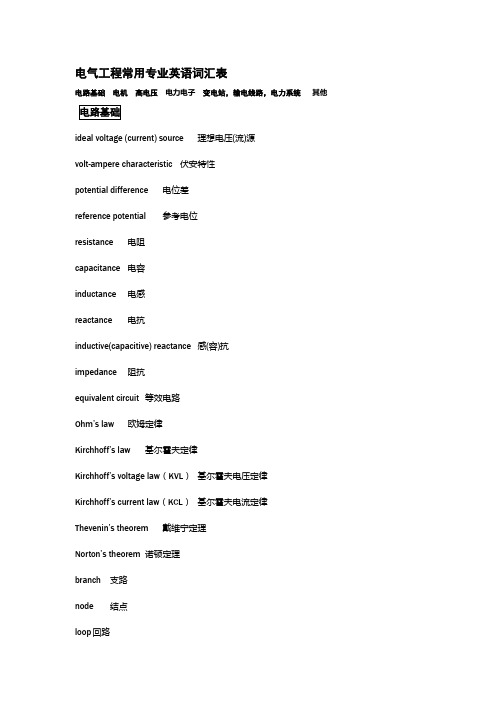电气工程专业英语unt
电气工程专业英语

电气工程专业英语词汇表 1generator 发电机gas insulated substation GIS 气体绝缘变电站turbogenerator 汽轮发电机neutral point 中性点hydrogenerator 水轮发电机moving contact 动触头hydraulic turbine 水轮机fixed contact 静触头steam turbine 汽轮机arc-extinguishing chamber 灭弧室dynamo 直流发电机stray capacitance 杂散电容motor 电动机stray inductance 杂散电感stator 定子sphere gap 球隙rotor 转子bushing tap grounding wire 套管末屏接地线power transformer 电力变压器electrostatic voltmeter 静电电压表variable transformer 调压变压器ammeter 电流表taped transformer 多级变压器grounding capacitance 对地电容step up (down) transformer 升(降)压变压器voltage divider 分压器circuit breaker CB 断路器surge impedance 波阻抗dead tank oil circuit breaker 多油断路器Schering bridge 西林电桥live tank oil circuit breaker 少油断路器Rogowski coil 罗可夫斯基线圈vacuum circuit breaker 真空断路器oscilloscope 示波器sulphur hexafluoride breaker SF6 断路器peak voltmeter 峰值电压表potential transformer PT 电压互感器conductor 导线current transformer CT 电流互感器cascade transformer 串级变压器disconnector 隔离开关coupling capacitor 耦合电容earthing switch 接地开关test object 被试品synchronous generator 同步发电机detection impedance 检测阻抗asynchronous machine 异步电机substation 变电站Insulator 绝缘子hydro power station 水力发电站lightning arrester 避雷器thermal power station 火力发电站metal oxide arrester MOA 氧化锌避雷器nuclear power station 核电站bus bar 母线oil-filled power cable 充油电力电缆overhead line 架空线mixed divider (阻容)混合分压器transmission line 传输线XLPE cable 交链聚乙烯电缆(coaxial) cable (同轴)电缆relay 继电器iron core 铁芯tuned circuit 调谐电路winding 绕组suspension insulator 悬式绝缘子bushing 套管porcelain insulator 陶瓷绝缘子front(tail) resistance 波头(尾)电阻glass insulator 玻璃绝缘子inverter station 换流站flash counter 雷电计数器steel-reinforced aluminumconductor钢芯铝绞线charging(damping) resistor 充电(阻尼)电阻tank 箱体point plane gap 针板间隙earth(ground) wire 接地线exciting winding 激磁绕组grading ring 均压环trigger electrode 触发电极highvoltage engineering 高电压工程glow discharge 辉光放电highvoltage testing technology 高电压试验技术harmonic 谐波Power electronics 电力电子Automatic control 自动控制Principles of electric circuits 电路原理Digital signal processing 数字信号处理电气工程专业英语词汇表 2power system 电力系统impulse current 冲击电流power network 电力网络impulse flashover 冲击闪络insulation 绝缘inhomogenous field 不均匀场overvoltage 过电压insulation coordination 绝缘配合aging 老化internal discharge 内部放电alternating current 交流电lightning stroke 雷电波AC transmission system 交流输电系统lightning overvoltage 雷电过电压arc discharge 电弧放电loss angle (介质)损耗角attachment coefficient 附着系数magnetic field 磁场attenuation factor 衰减系数mean free path 平均自由行程anode (cathode) 阳极(阴极)mean molecular velocity 平均分子速度breakdown (电)击穿negative ions 负离子bubble breakdown 气泡击穿non-destructive testing 非破坏性试验cathode ray oscilloscope 阴极射线示波器non-uniform field 不均匀场cavity 空穴,腔partial discharge 局部放电corona 电晕peak reverse voltage 反向峰值电压composite insulation 组合绝缘photoelectric emission 光电发射critical breakdown voltage 临界击穿电压photon 光子Discharge 放电phase-to-phase voltage 线电压Dielectric 电介质,绝缘体polarity effect 极性效应dielectric constant 介质常数power capacitor 电力电容dielectric loss 介质损耗quasi-uniform field 稍不均匀场direct current 直流电radio interference 无线干扰divider ratio 分压器分压比rating of equipment 设备额定值grounding 接地routing testing 常规试验electric field 电场residual capacitance 残余电容electrochemical deterioration 电化学腐蚀shielding 屏蔽electron avalanche 电子崩short circuit testing 短路试验electronegative gas 电负性气体space charge 空间电荷epoxy resin 环氧树脂streamer breakdown 流注击穿expulsion gap 灭弧间隙surface breakdown 表面击穿field strength 场强sustained discharge 自持放电field stress 电场力switching overvoltage 操作过电压field distortion 场畸变thermal breakdown 热击穿field gradient 场梯度treeing 树枝放电field emission 场致发射uniform field 均匀场flashover 闪络wave front(tail) 波头(尾)gaseous insulation 气体绝缘withstand voltage 耐受电压Prime mover 原动机Power factor 功率因数Torque 力矩Distribution automation system 配电网自动化系统Servomechanism 伺服系统Automatic meter reading 自动抄表Boiler 锅炉Armature 电枢Internal combustion engine 内燃机Brush 电刷Deenergize 断电Commutator 换向器Underground cable 地下电缆Counter emf 反电势Loop system 环网系统Demagnetization 退磁,去磁Distribution system 配电系统Relay panel 继电器屏Trip circuit 跳闸电路Tertiary winding 第三绕组Switchboard 配电盘,开关屏Eddy current 涡流Instrument transducer 测量互感器Copper loss 铜损Oil-impregnated paper 油浸纸绝缘Iron loss 铁损Bare conductor 裸导线Leakage flux 漏磁通Reclosing 重合闸Autotransformer 自耦变压器Distribution dispatch center 配电调度中心Zero sequence current 零序电流Pulverizer 磨煤机Series (shunt) compensation 串(并)联补偿Drum 汽包,炉筒Restriking 电弧重燃Superheater 过热器Automatic oscillograph 自动录波仪Peak-load 峰荷Tidal current 潮流Prime grid substation 主网变电站Trip coil 跳闸线圈Reactive power` 无功功率Synchronous condenser 同步调相机Active power 有功功率Main and transfer busbar 单母线带旁路Shunt reactor 并联电抗器Feeder 馈电线Blackout 断电、停电Skin effect 集肤效应Extra-high voltage (EHV) 超高压Potential stress 电位应力(电场强度)Ultra-high voltage (UHV) 特高压Capacitor bank 电容器组Domestic load 民用电crusher 碎煤机Reserve capacity 备用容量pulverizer 磨煤机Fossil-fired power plant 火电厂baghouse 集尘室Combustion turbine 燃气轮机Stationary (moving) blade 固定(可动)叶片Right-of-way 线路走廊Shaft 转轴Rectifier 整流器Kinetic(potential) energy 动(势)能Inductive (Capacitive) 电感的(电容的) Pumped storage power station 抽水蓄能电站Reactance (impedance) 电抗(阻抗)Synchronous condenser 同步调相机Reactor 电抗器Light(boiling)-water reactor 轻(沸)水反应堆Reactive 电抗的,无功的Stator(rotor) 定(转)子Phase displacement (shift) 相移Armature 电枢Surge 冲击,过电压Salient-pole 凸极Retaining ring 护环Slip ring 滑环Carbon brush 炭刷Arc suppression coil 消弧线圈Short-circuit ratio 短路比Primary(backup) relaying 主(后备)继电保护Induction 感应Phase shifter 移相器Autotransformer 自藕变压器Power line carrier (PLC) 电力线载波(器)Bushing 套管Line trap 线路限波器Turn (turn ratio) 匝(匝比,变比)Uninterruptible power supply 不间断电源Power factor 功率因数Spot power price 实时电价Tap 分接头Time-of-use(tariff) 分时(电价)Recovery voltage 恢复电压XLPE(Cross Linked Polyethylene )交联聚乙烯(电缆)Arc reignition 电弧重燃Rms (root mean square) 均方根值Operation mechanism 操动机构RF (radio frequency) 射频Pneumatic(hydraulic) 气动(液压)Rpm (revolution per minute) 转/分Nameplate 铭牌LAN (local area network) 局域网Independent pole operation 分相操作LED (light emitting diode) 发光二极管Malfunction 失灵Single (dual, ring) bus 单(双,环形)母线Shield wire 避雷线IC (integrated circuit) 集成电路Creep distance 爬电距离FFT (fast Fourier transform) 快速傅立叶变换Silicon rubber 硅橡胶Telemeter 遥测Composite insulator 合成绝缘子Load shedding 甩负荷Converter (inverter) 换流器(逆变器)Lateral 支线Bus tie breaker 母联断路器Power-flow current 工频续流Protective relaying 继电保护sparkover 放电Transfer switching 倒闸操作Silicon carbide 碳化硅Outgoing (incoming) line 出(进)线Zinc oxide 氧化锌Phase Lead(lag) 相位超前(滞后)Withstand test 耐压试验Static var compensation (SVC) 静止无功补偿Dispatcher 调度员Flexible AC transmission system (FACTS) 灵活交流输电系统Supervisory control and data acquisition (SCADA) 监控与数据采集EMC (electromagnetic compatibility) 电磁兼容ISO (international standardization organization) 国际标准化组织GIS (gas insulated substation, geographic information system) 气体绝缘变电站地理信息系统三绕组变压器:three-column transformer ThrClnTrans双绕组变压器:double-column transformer DblClmnTrans电容器:Capacitor并联电容器:shunt capacitor电抗器:Reactor母线:Busbar输电线:TransmissionLine发电厂:power plant断路器:Breaker刀闸(隔离开关):Isolator分接头:tap电动机:motor(2)状态参数有功:active power无功:reactive power电流:current容量:capacity电压:voltage档位:tap position有功损耗:reactive loss无功损耗:active loss功率因数:power-factor功率:power功角:power-angle电压等级:voltage grade空载损耗:no-load loss铁损:iron loss铜损:copper loss空载电流:no-load current阻抗:impedance正序阻抗:positive sequence impedance 负序阻抗:negative sequence impedance 零序阻抗:zero sequence impedance电阻:resistor电抗:reactance电导:conductance电纳:susceptance无功负载:reactive load 或者QLoad有功负载: active load PLoad遥测:YC(telemetering)遥信:YX励磁电流(转子电流):magnetizing current 定子:stator功角:power-angle上限:upper limit下限:lower limit并列的:apposable高压: high voltage低压:low voltage中压:middle voltage电力系统power system发电机generator励磁excitation励磁器excitor电压voltage电流current母线bus变压器transformer升压变压器step-up transformer高压侧high side输电系统power transmission system输电线transmission line固定串联电容补偿fixed series capacitor compensation 稳定stability电压稳定voltage stability功角稳定angle stability暂态稳定transient stability电厂power plant能量输送power transfer交流AC装机容量installed capacity电网power system落点drop point开关站switch station双回同杆并架double-circuit lines on the same tower 变电站transformer substation补偿度degree of compensation高抗high voltage shunt reactor无功补偿reactive power compensation故障fault调节regulation裕度magin三相故障three phase fault故障切除时间fault clearing time极限切除时间critical clearing time切机generator triping高顶值high limited value强行励磁reinforced excitation线路补偿器LDC(line drop compensation)机端generator terminal静态static (state)动态dynamic (state)单机无穷大系统one machine - infinity bus system机端电压控制A VR电抗reactance电阻resistance功角power angle有功(功率)active power无功(功率)reactive power功率因数power factor无功电流reactive current下降特性droop characteristics斜率slope额定rating变比ratio参考值reference value电压互感器PT分接头tap下降率droop rate仿真分析simulation analysis传递函数transfer function框图block diagram受端receive-side裕度margin同步synchronization失去同步loss of synchronization 阻尼damping摇摆swing保护断路器circuit breaker电阻:resistance电抗:reactance阻抗:impedance电导:conductance电纳:susceptance导纳:admittance电感:inductance电容: capacitance。
电气工程专业英语+unt3

robot n. 机器人;
Hydraulic 水力的,水压的;
Cylinder 圆柱;汽缸; Military adj. 军事的;
saw n. 锯;v. 往复移动; blade 刀片;剑
Blender 掺和器on text
3.1.1 Elementary Concepts of Electrical Machines Various types of electrical machines are widely employed in industries, power stations, domestic and com-mercial appliances, etc.
synonymous. 同步的 generator n. 发电机,发生器;
electro-mechanical 机电 rotate 旋转;使转动;
utilize 利用;使用 electromagnetic [物]电磁的
phenomena 现象 approximately 近似地;
Virtually adv. 实际上;实质上;
Note:①:are virtually overlooked as几乎被忽视; ② integral component of the entire electricity infrastructure
整个电力基础设施不可分割的组成部分
Note:③ alternative energy 替代能源
3.1 Introduction text
3.1 Introduction text
Motors and generators can be designed with or without iron to improve the path of the magnetic field (teeth to reduce the air gap is a common example) and with and without permanent magnets (PM), with different pole number etc., but still belong to different classes of machines.
电气工程专业英语unt

1.1 Introduction to Circuit Theory text
A node is usually indicated by a dot in a circuit. If a short circuit a connecting wire connects two nodes the two nodes constitute a single node. The circuit in Fig.1.1 has three nodes a b and c. Notice that the three points that form node b ① are connected by perfectly conducting wires and therefore constitute a single point.
Note:①containing the 2Ω resistor 作定语修饰 closed path abca 意为包含2Ω电阻的闭合路径abca
1.1 Introduction to Circuit Theory text
As the next two definitions show circuit topology is of great value =is very valuableto the study of voltages and currents in an electric circuit. Two or more elements are in series 串联if they are cascaded or connected sequentially 接顺序连接and consequently carry the same current流过相同电流. Two or more elements are in parallel 并联if they are connected to the same two nodes and consequently have the same voltage across them①.
电气工程导论专业英语

专业英语概述结构:1长句多2被动语态,非谓语动词3介词短语多4名词性词很多5虚拟语气6专业术语翻译标准:准确明白,通顺严密,简练全面做法:1语法知识2专业、科学知识3汉语修养4翻译方法、技巧翻译过程:1理解阶段2表达阶段3校核阶段惯用时态:1一般现在时2被动语态3非限定性动词4大量使用名词介词短语5条件英语较多6长句较多Anti——/counter 反,抗,防,逆anti—interference 抗干扰anti—phase 反相Counter clockwise 逆时针counter current 反向电流——auto ——自动auto transformer 自耦变压器auto coder 自动编码器auto modulation 自调制auto mobile汽车bi——双重bipolar relay 双极继电器co——共同一起相互cosine 余弦coaxial cable 同轴电缆de——相反动作demodulator 解调器deform 变形deci——十分之一,分decimal 十进制decibel 分贝decimeter 分米Di——双,偶,两diode 二极管dioxide 二氧化物Dis——反义词displace 位移disconnect 断开Equi——同等,均equilibrium 均衡,平衡Hydro——水,氢化hydrodynamic 水力的,流体。
动力学的hydroelectric 水力发电的In——否定invariable 不变的Inter——相互,隔离internet 互联网interchange 互换interface 界面intercity train 城际列车Mal——不,失malfunction故障,失灵malformation 畸形Mega——兆,百万megawatt 兆瓦megaton 百万吨Micro——百万分之一microelectronics微电子学microcomputer 微机micrometer 毫米microwave 微波Mini——小minicomputer 小型计算机minibus 微型公交车Multi——多multi—frequency 多频率over ——过,超,太over-frequency 超频Photo——光,光电,光敏photocell 光电池photoreceptor 感光器Post——后post fault 故障后Pre——在前,预先preheat 预热precondition 前提Semi——半semiconductor 半导体Sub——子,亚,低,次subsystem 子系统substation 变电站sub code 子码Tele——远,电telecommunicate 电信tele—control 遥控tele switch 遥控开关Thermo——热thermoelectric 热电的thermostat 恒温器Tri——三triangle 三角形Ultra——超过ultrasonic 超声波Un——相反unequal 不等unvarying 不变的专业英语的词汇特点后缀——able ……的stable稳定的comparable 可比较的——al ……的digital 数字的functional 功能性的。
电气工程专业英语词汇汇总

电气工程专业英语词汇汇总 10kV distribution substation 10kV 配电所abrupt change of voltage电压突变accumulation of electric energy电能存储actuating coil动作线圈adjustment diagram调整图alarm 报警alarm signal报警信号alternating light变光灯ammeter 电流表apparent energy consumption unit单位视在能耗arc furnace电弧炉armature 电枢arrester; lighting arrester; surge diverters避雷器 automatic voltage regulator电压自动调整器backlighting; background illumination背景照明battery box电池箱battery charger电池充电器battery contactor电池接触器battery fuse电池保险丝battery resistor电池电阻器blow-out coil磁吹线圈boom 吊杆bracket (OCS)底座(接触网);支架;托架bracket for headspan wire定位索底座bridge 电桥brush 电刷built-in wardrobe; built-in closet; closet壁灯bulb; light(lamp) bulb; electric bulb灯泡butterfly valve with electric actuator电动蝶阀button 电钮cable and accessories电缆及附件cable armour电缆铠装cable bays电缆电线间隔cable box电缆箱cable bracket; cable tray电缆托架cable continuity test电路复测cable differential protection电缆差动保护cable distribution cabinets (CDCs )电缆分线箱(电缆分歧箱) cable drum电缆盘cable duct cable conduit电缆管道cable duct; cable trench电缆沟cable end; cable lug电缆端头cable fault locator电缆故障探测仪cable gallery电缆廊道cable hanger; cable suspender电缆吊架cable laying laying of cables电缆敷设cable marking电缆标志cable rack电缆架cable shaft电缆竖井cable sleeve; electrical wire conduit电缆套管cable support电缆支架cable tapping box电缆分接箱cable terminal电缆终端cable terminal box电缆盒cable tray电缆托架cable trenches with chequer plates带方形盖板的电缆沟槽 cable trough电缆沟槽cable trough; trough电缆槽cable tunnel; cable-subway电缆隧道cable vault电缆室cable work电缆厂capacitance 电容capacitance compensation电容补偿capacitive charges电容电荷capacitive voltage transformer电容式电压互感器 capacitor 电容器capacitor bank电容器组capacitor compensator电容补偿器capacitor coupling电容耦合capacitor filtering电容滤波catenary/messenger承力索catenary; messenger wire; catenary wire承力索 ceiling lamp ceiling light 顶灯ceramic wall bushings穿墙套管changeover box电源切换箱changeover box for smoke curtain挡烟垂幕电源切换箱 circuit 电路circuit connection电路接线circuit diagram电路图circuit diagrams电路图circuit diagrams电路图circuit parameter电路参数circuit-breaker unit断路器单元closed circuit闭路closed circuit TV (CCTV)闭路电视cod for electrical design and installation电气设计安装规范 coefficient of resistivity电阻系数compensation 补偿compensation reactor补偿电抗器concealed piping; concealed pipe暗管concealed wiring; concealed electric wiring暗线 condenser 电容器condenser bank(block)电容器组condenser charge电容器充电condenser discharge电容器放电condenser reactance电容器电抗conductor 导线conductor rail导电轨conductor resistance导体电阻contact 触头。
电气工程常用专业英语词汇表资料

电气工程常用专业英语词汇表电路基础电机高电压电力电子变电站,输电线路,电力系统其他ideal voltage (current) source 理想电压(流)源volt-ampere characteristic 伏安特性potential difference 电位差reference potential 参考电位resistance 电阻capacitance 电容inductance 电感reactance 电抗inductive(capacitive) reactance 感(容)抗impedance 阻抗equivalent circuit 等效电路Ohm’s law欧姆定律Kirchhoff’s law基尔霍夫定律Kirchhoff’s voltage law(KVL)基尔霍夫电压定律Kirchhoff’s current law(KCL)基尔霍夫电流定律Thevenin’s theorem戴维宁定理Norton’s theorem诺顿定理branch 支路node 结点loop 回路mesh 网孔open circuit 开路(断路)short circuit 短路branch current analysis 支路电流法mesh current analysis 网孔电流法ode voltage analysis 结点电位法nsuperposition theorem 叠加原理passive(active) two-terminal network 无(有)源二端网络root mean square (RMS) 均方根值effective value 有效值instantaneous value 瞬时值ampere 安培volt 伏特Hertz 赫兹reactive power` 无功功率active power 有功功率transfer function 传递函数apparent power 视在功率power-factor compensation 功率因数补偿series (parallel) resonance 串(并)联谐振amplitude(phase)-frequency response characteristic 幅(相)频特性figure of merit 品质因素pass-band 通频带bandwidth (BW) 带宽first(second)-order filter 一(二)阶滤波器low(high)-pass filter 低(高)通滤波器band-pass(stop) filter 带通(阻)滤波器transfer function 转移函数Bode diagram 波特图Fourier series 傅立叶级数three-phase circuit 三相电路cutoff frequency 截止频率FFT (Fast Fourier Transform) 快速傅立叶变换state variable 状态变量generation 发电transmission 输电distribution 配电coil 线圈core 铁心winding 绕组electrical machine 电机generator 发电机motor 电动机stator (rotor) 定子(转子)armature 电枢brush 电刷commutator 换向器salient-pole 凸极slip ring 滑环induction motor 感应电动机magnetic flux 磁通asynchronous machine 异步电机synchronous generator 同步发电机eddy current 涡流EMF(electromotive force)电动势counter EMF 反电势torque 转矩excitation 励磁prime mover 原动机rectifier 整流器leakage flux 漏磁通demagnetization 退磁,去磁short-circuit ratio 短路比converter (inverter) 换流器(逆变器)synchronous condenser 同步调相机magnetization curve 磁化曲线separately exciting 他励compounded excited 复励self-exciting 自励series(shunt)-wound 串(并)励bearing 轴承Extra-high voltage (EHV) 超高压Ultra-high voltage (UHV) 特高压insulation 绝缘overvoltage 过电压lightning arrester 避雷器metal oxide arrester MOA 氧化锌避雷器Insulator 绝缘子circuit breaker CB 断路器vacuum circuit breaker 真空断路器earth(ground) wire 接地线grading ring 均压环aging 老化arc discharge 电弧放电breakdown (电)击穿Dielectric 电介质,绝缘体corona 电晕dielectric constant 介质常数dielectric loss 介质损耗divider ratio 分压器分压比electric field 电场field strength 场强field stress 电场力field distortion 场畸变field gradient 场梯度flashover 闪络gaseous (solid ,liquid) insulation 气(固,液)体绝缘space charge 空间电荷shielding 屏蔽routing testing 常规试验rating of equipment 设备额定值polarity effect 极性效应non-destructive testing 非破坏性试验partial discharge 局部放电impulse current 冲击电流impulse flashover 冲击闪络uniform field 均匀场inhomogenous field 不均匀场insulation coordination 绝缘配合internal discharge 内部放电lightning stroke 雷电波non-uniform field 不均匀场streamer breakdown 流注击穿short circuit testing 短路试验space charge 空间电荷surface breakdown 表面击穿sustained discharge 自持放电switching overvoltage 操作过电压lightning overvoltage 雷电过电压withstand voltage 耐受电压wave front(tail) 波头(尾)Schering bridge 西林电桥point plane gap 针板间隙composite insulator 合成绝缘子recovery voltage 恢复电压restriking 电弧重燃rated voltage(current) 额定电压(电流)oil-impregnated paper 油浸纸绝缘XLPE(Cross Linked Polyethylene ) 交联聚乙烯(电缆)volt-time characteristics 幅秒特性partial discharge 局部放电switchgear 开关装置temporary overvoltages 暂态过电压peak voltmeter 峰值电压表cascade transformer 串级变压器coupling capacitor 耦合电容test object 被试品detection impedance 检测阻抗Dissolved Gas Analysis (DGA) 溶解气体分析voltage divider 分压器regulator 调压器electrostatic voltmeter 静电电压表impulse current (voltage) generator 冲击电流(压)发生器online monitoring 在线监测preventive test 预防性试验test object 被试品operation amplifier 运算放大器active (passive )filter 有(无)源滤波器Uninterruptible Power Supply 不间断电源analytical 解析的numerical 数字的frequency-domain 频域time-domain 时域operation amplifier 运算放大器amplitude modulation (AM) 调幅frequency modulation (FM) 调频integrated circuit (IC) 集成电路semiconductor 半导体diode 二极管thyristor 晶闸管transistor 晶体管triac 双向可控硅silicon 硅crystal 晶体anode 阳极cathode 阴极collector 集电极emitter 发射极capability 容量horseppower 马力modulation 调制demodulation 解调analog electronics 模拟电子学digital electronics 数字电子学analog to digital conversion (ADC) 模数转换oscilloscope 示波器invertering (uninvertering)amplifier 反(同)相放大器feedback 反馈feedforward 前馈open (closed) loop 开(闭)环signal to noise ratio (SNR) 信噪比transistor to transistor logic (TTL) 晶体管-晶体管逻辑light emitting diode (LED) 发光二极管power supply 电源power system 电网voltage 电压current 电流alternating current ( AC) 交流direct current (DC) 直流transformer 变压器power transformer 电力变压器step-up(down) transformer 升(降)压变压器bushing 套管high voltage 高压low voltage 低压middle voltage 中压no-load loss 空载损耗neutral point 中性点iron loss 铁损copper loss 铜损turn (turn ratio) 匝(匝比,变比)tap 分接头outgoing (incoming) line 出(进)线power transmission system 输电系统transmission line 输电线phase-to-phase (line) voltage 线电压phase voltage 相电压substation 变电站bus bar 母线potential transformer PT 电压互感器current transformer CT 电流互感器disconnect switch 隔离开关earthing switch 接地开关rogowski coil 罗可夫斯基线圈oscilloscope 示波器surge impedance 波阻抗grounding capacitance 对地电容arc suppression coil 消弧线圈power factor 功率因数steel-reinforced aluminum conductor 钢芯铝绞线radio interference 无线干扰primary(backup) relaying 主(后备)继电保护protective relaying 继电保护skin effect 集肤效应series (shunt) compensation 串(并)联补偿tidal current 潮流blackout 断电、停电margin 裕度fault 故障three phase fault 三相故障surge 冲击damping 阻尼Load shedding 甩负荷voltage grade 电压等级positive sequence impedance 正序阻抗negative sequence impedance 负序阻抗zero sequence impedance 零序阻抗phase lead(lag) 相位超前(滞后)Shunt reactor 并联电抗器neutral line 中线transient state 暂态steady state 稳态Phase displacement (shift) 相移symmetrical three-phase source(load)对称三相电源(负载) three-phase three(four)-wire system 三相三(四)线制star connection(Y-connection) 星形连接triangular connection(D- connection ,delta connection) 三角形连接zero sequence current 零序电流underground cable 地下电缆capacity 容量subnet 子网primary (secondary)winding 一次(二次)线圈,原(副)边servomechanism 伺服系统oscillatory 摆动的nameplate 铭牌harmonic 谐波damped 阻尼的conductor 导线overhead line 架空线transmission line 传输线Electrical Machinery 电机学Automatic Control Theory 自动控制理论Electromagnetic Field 电磁场Principle of Microcomputer 微机原理Electrotechnics 电工学Principle of circuits 电路原理Steady-State Analysis of Power System 电力系统稳态分析Transient-State Analysis of Power System 电力系统暂态分析Principle of Electrical System's Relay Protection 电力系统继电保护原理Protection Principle of Power System 's Element 电力系统元件保护原理Basic fundamentals of power electronics 电力电子基础Analogue Electronic Technique 模拟电子技术Digital Electrical Technique 数字电子技术High voltage engineering 高电压工程Introduction to electrical engineering 电气工程概论highvoltage testing technology 高电压试验技术Electrical Drive and Control 电力传动与控制Power System Relaying Protection 电力系统继电保护Power electronics 电力电子EMC(electromagnetic compatibility) 电磁兼容servomechanism 伺服系统static (state) 静态dynamic (state) 动态resonance 谐振,共振fuse 保险丝,熔丝scale 刻度,量程rated 额定的modulator 调制器demodulator 解调器terminal 接线端子calibrate 校准IEEE (Institute of Electrical and Electronic Engineers) 电气与电子工程师学会(美)IEE (Institution of Electrical Engineers) 电气工程师学会(英)IEC (international Electrotechnical Commission) 国际电工(技术)委员会ripple 纹波wide area network (WAN) 广域网local area network (LAN) 局域网voltmeter 伏特表ohmmeter 欧姆表wattmeter 瓦特表ammeter 安培表multimeter 万用表sensor 传感器transducer 传感器,变换器。
电气工程专业英语+unt1参考文档

Unit 1 Fundamentals of Electronic Circuits
1.1 Introduction to Circuit Theory 1.2 Analog and Digital Circuits 1.3 Three-Phase Circuits 1.4 Further Reading
Notice that the three points that form node b ① are connected by perfectly conducting wires and therefore constitute a single point.
Note:① "three points that form node b "表示"形成节点
b的3个点".此句可译为:注意到形成节点b的3个点是通过理
elements or devices, whereas a circuit is a network
providing one or more closed paths③.
Note:②:regard … as表示“把…认为” NNoottee::③①::pdrioffveirtfherse为ntiate nbeettwwoerekn的A后an置d 定B表语示。区分A和B;To differentiate between a circuit and a network是目的状语从句.
series
n. 连续;系列;级数;串联
parallel
adj. 平行的;并联的 n. 平行线;平
行面;v. 相应;平行
impedance
n. [电]阻抗;全电阻;[物]阻抗
theorem
n. [数]定理;法则
电气工程专业英语

电气工程专业英语 Final approval draft on November 22, 2020电路electriccircuit电气工程electricalengineering电机electricmachine自然科学physicalscience电气设备electricaldevice电器元件electricalelement正电荷positivecharge负电荷negativecharge直流directcurrent交流alternatingcurrent电压voltage导体conductor功work电动势electromotiveforce电势差potentialdifference功率power极性polarity能量守恒定律thelawofconservationenergy 变量variable电阻resistance电阻率resistivity绝缘体insulator电阻器resistor无源元件passiveelement常数constant电导conductance短路shortcircuit开路opencircuit线性的linear串联series并联parallel电压降voltagedrop等效电阻equivalentresistance电容器capacitor电感器inductor储能元件storageelement电场electricfield充电charge放电discharge动态的dynamic电介质dielectric电容capacitance磁场magneticfield电源powersupplu变压器transformer电机electricmotor线圈coil电感inductance导线conductingwire绕组wingding漏电阻leakageresistance电子系统electronicsystem结构图blockdiagram功能模块functionalblock放大器amplifier滤波器filter整形电路wave-shapingcircuit振荡器oscillator增益gain输入阻抗inputimpedance带宽bandwidth晶体管transistor集成电路integratedcircuit电力电子powerelectronics数字信号处理digitalsignal-processing输出装置outputdevice模拟信号analogsignal数字信号digitalsignal传感器transducer采样值samplevalue模数转换器analog-to-digitalconverter频谱frequencycontent采样频率samplingrateorfrequendy扰动disturbance分立电路discretecircuit数字化信号digitizedsignal运算放大器operationalamplifier有源电路activecircuit电子部件electronicunit封装package管脚pin同相端noninvertingterminal反相输入invertinginput电路图circuitdiagram压控电压源voltage-controlledvoltagesource 开环增益open-loopgain闭环增益closed-loopgain负反馈negativefeedback正饱和positivesaturation线性区linearregion电压跟随器voltagefollower等效阻抗equivalentimpedance逻辑变量logicvariable位bit数字字digitalword字节byte半字节nibble与运算ANDoperation真值表truthtable与门ANDgate非门NOTgate或门ORgate加号additionsign与非门NANAgate异或运算XORoperation逻辑表达式logicexpression二进制binarysystem正逻辑positivelogic负逻辑negativelogic参考方向referencedirection理想变压器idealtransformer电气绝缘electricalisolation阻抗匹配impedancematching电力electricalpewer绝缘变压器isolatingtransformer电压互感器voltagetransformer电流互感器currenttransformer原边绕组primarywinding工作频率operatingfrequency配电变压器distributiontransformer 电力变压器powertransformer磁通密度fluxdensity磁场magneticfield铁芯变压器iron-coretransformer大功率high-power空芯air-core磁耦合magneticcoupling小功率lower-power励磁损耗magnetizingloss磁滞损耗hysteresisloss涡流eddycurrent励磁电流excitingcurrent漏磁通leakageflux互磁通mutualflux线圈coil芯式coreform壳式shellform高压绕组high-voltagewinding磁链fluxlinkage电动势electromotiveforce有效值rootmeansquarevalue匝数比turnsratio视在功率apparentpower匝数thenumberofturns升压变压器step-uptransformer 降压变压器step-downtransformer 电动机motor发电机generator机械能mechanicalenergy电能electricalenergy电磁的electromagnetic直线式电动机linearmotor同步电机synchronousmachine感应电机inductionmachine定子stator转子rotor气隙airgap轴shaft电枢armature励磁绕组fieldwinding无功功率reactivepower制动状态brakingmode稳态steady-state相序phasesequence反响制动plugging滞后电流laggingcurrent励磁电抗magnetizingreactance 启动电流startingcurrent变频器frequencychanger感应电势inducedvoltage逆变器inverter周波变换器cycloconverter换向器commutator自动控制automaticcontrol控制器controller扰动disturbance期望值desiredvalue压力pressure液位liquidlevel被控变量controlledvariable 方框图blockdiagram传递函数transferfunction工程控制processcontrol伺服系统servomechanism流率flowrate加速度acceleration前向通路forwardpath补偿correction反馈通路feedbackpath闭环closed-loop开环open-loop输出output增益gain手动调节manualadjustment变送器transducer误差error控制方式controlmode比例控制proportionalcontrol 积分控制integralcontrol微分控制derivativecontrol 执行元件manipulatingelement 调节时间settingtime残差residualerror不确定度uncertainty观测数据observations采样sample算术平均arithmeticaverage 期望值expectedvalue标准偏差standarddeviation 下限lowerrangelimit上限upperrangelimit跨度span分辨率resolution死区deadband灵敏度sensitivity阈值threshold可靠性reliability过量程overrange恢复时间recoverytime过载overload过量程极限overrangelimit漂移drift准确性accuracy误差error重复性repeatability系统误差systemicerror再现性reproducibility校准calibration线速度linearvelocity角速度angularvelocity弧度radian测速仪tachometer增量式编码器incrementalencoder定时计数器timedcounter稳定性stability接口interface调节器conditioner开关switch执行器actuator电磁阀solenoidvalve连续控制系统sequentialcontrolsystem 触点contact常开normallyopen常闭normallyclosed限位开关limitswitch继电器relay延时继电器time-delayrelay接通电流pull-incurrent开断电流drop-outcurrent电机启动器motorstarter接触器contactor自锁触点holdingcontact整流器rectifier变流器converter逆变器inverter二极管diode阳极anode阴极cathode正向偏置forwardbiased反向偏置reversebiased阻断block稳压二极管zenerdiode晶体管transistor集电极collector基极base发射极emitter共发射极common-emitter双向晶闸管triac正半周positivehalf-cycle触发电流triggercircuit功率容量powercapability功率器件powerdevice晶闸管thyristor导通conduction正向阻断forward-blocking通态on-state关断状态off-state反向击穿电压reversebreakdownvoltage漏电流leakagecurrent电流额定值currentrating漏极drain门极gate缓冲电路snubbercircuit均流currentsharing额定电压ratedvoltage可控开关controllableswitch相控phase-controlled充电器charger工频line-frequency变换器converter整流rectification逆变inversion可逆调速revesible-speed再生制动regenerativebarking关断时间turn-offtime纯电阻负载pureresistiveload脉动ripple感性负载inductanceload周期timeperiod带内部直流电动势的负载loadwitnaninternalDCvoltage 波形waveform换相commutation稳态steadystate交流侧AC-side延时角delayangle交点intersection电力系统powersystem发电厂generatingplant发电机generator负荷load输电网transmissionnerwork配电网distributionnetwork电electricity天然气naturalgas原理图schematicdiagram锅炉boiler热效率thermalefficiency风力windpower断路器circuitbreaker变电所substation故障fault过电压overvoltage击穿值breakdownvalue过电流overcurrent可靠性reliability继电器relay触点contact电流互感器currenttransformer合闸线圈operatingcoil分闸线圈tripcoil Circuittheoryisalsovaluabletostudentsspecializinginotherbranchesofthephysicalsciencebecau secircuitareagoodmodelforthestudyofenergysystemingeneral,andbecauseoftheappliedmathematic s,physics,andtopologyinvolved.电路理论对于专门研究自然科学其他分支的学生来说也十分有价值,因为电路一般可以很好地作为能量系统研究的模型,并且电路理论涉及应用数学、物理学和拓扑学的相关知识。
- 1、下载文档前请自行甄别文档内容的完整性,平台不提供额外的编辑、内容补充、找答案等附加服务。
- 2、"仅部分预览"的文档,不可在线预览部分如存在完整性等问题,可反馈申请退款(可完整预览的文档不适用该条件!)。
- 3、如文档侵犯您的权益,请联系客服反馈,我们会尽快为您处理(人工客服工作时间:9:00-18:30)。
A loop is said to be (可认为是)independent if it contains a branch which is not in any other loop.
The two circuits in Fig.1.1 and Fig.1.2 are identical.
However, for the sake of clarity②, nodes b and c are spread out ③with perfect conductors as in Fig.1.2.
Notice that the three points that form node b ① are connected by perfectly conducting wires and therefore constitute a single point.
Note:① "three points that form node b "表示"形成节点
Two or more elements are in series (串联)if they are cascaded or connected sequentially (接顺序连接)and consequently carry the same current(流过相同电流).
Two or more elements are in parallel (并联)if they are connected to the same two nodes and consequently
abca ,意为包含2Ω电阻的闭合路径abca。
1.1 Introduction to Circuit Theory text
As the next two definitions show, circuit topology is of great value (=is very valuable)to the study of voltages and currents in an electric circuit.
Independent loops or paths result in( 导致,结果是)
independent sets of equations.
1.1 Introduction to Circuit Theory text
For example, the closed path abca containing the 2Ω resistor ① in Fig.1.2 is a loop. Another loop is the closed istor and the current source. Although one can identify six loops in Fig.1.2, only three of them are independent.
电气工程及其自动化专业英语
主编 杨勇 邓秋玲
CONTENTS
Unit 1 Fundamentals of Electronic Circuits Unit 2 Power Electronics Unit 3 Electrical Machines Unit 4 Electric Power Systems Unit 5 Electric Power Generations Unit 6 Automatic Control Unit 7 Sensoring Technology Unit 8 Computer Network and Networked Control Unit 9 Signal Processing
Unit 1 Fundamentals of Electronic Circuits
1.1 Introduction to Circuit Theory 1.2 Analog and Digital Circuits 1.3 Three-Phase Circuits 1.4 Further Reading
A node is the point of connection between two or more branches.
1.1 Introduction to Circuit Theory text
A node is usually indicated by a dot in a circuit. If a short circuit (a connecting wire) connects two nodes, the two nodes constitute a single node. The circuit in Fig.1.1 has three nodes a, b, and c.
A network with b branches, n nodes, and l independent loops will satisfy the fundamental theorem of network topology:
b = l + n-1 (1.1)
Note:①containing the 2Ω resistor 作定语修饰 closed path
elements or devices, whereas a circuit is a network
providing one or more closed paths③.
Note:②:regard … as表示“把…认为” NNoottee::③①::pdrioffveirdeintgiaotnee在o此r m处o为re动clo词se,d dpiaftfherse为ntiate nbeettwwoerekn的A后an置d 定B表语示。区分A和B;To differentiate between a circuit and a network是目的状语从句.
A branch represents a single element such as a voltage source or a resistor. In other words, a branch represents any two-terminal element. The circuit in Fig.1.1 has five branches, namely, the 10V voltage source, the 2A current source, and the three resistors.
n. 循环,回路; vt. 使成环;
n. 拓扑;布局;拓扑学 n. 构造;结构;配置;外形 n. 终点站;终端;接线端
1.1 Introduction to Circuit Theory
New Words and Expressions
resistor
n. [电]电阻器
independent adj. 独立自主的;不受约束的
voltage across them②. The 5Ω and 2Ω resistors are
series
n. 连续;系列;级数;串联
parallel
adj. 平行的;并联的 n. 平行线;平
行面;v. 相应;平行
impedance
n. [电]阻抗;全电阻;[物]阻抗
theorem
n. [数]定理;法则
1.1 Introduction to Circuit Theory text
(1) Nodes, Branches and Loops Since the elements of an electric circuit can be
The 2Ω resistor, the 3Ω resistor, and the current source are in parallel because they are connected to the same two nodes (b and c) and consequently have the same
1.1 Introduction to Circuit Theory
New Words and Expressions
element interconnect node branch loop topology configuration terminal
n. 成分;元件 vt. 使互相连接
n. 节点 n. 分枝;分部;支流 v. 出现分歧
A loop is any closed path in a circuit. A loop is a closed path formed by starting at a node, passing through a set of nodes, and returning to the starting node without passing through any node more than once①.
1.1 Introduction to Circuit Theory text
In network topology, we study the properties relating to (关于...的特性)the placement of elements in the network and the geometric configuration of the network. Such elements include branches, nodes, and loops.
have the same voltage across them①.
Note:①:voltage across them表示关于两节点之间的电压, “them”指代“two nodes ”。
1.1 Introduction to Circuit Theory text
